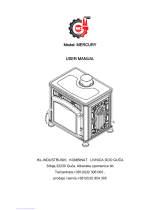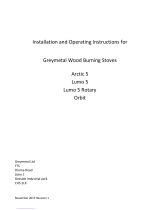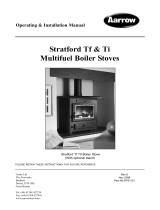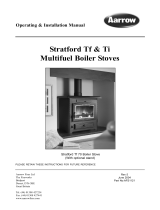Page is loading ...

JD 320/Viking 30
Installaon and maintenance manual
A

Technical data 4
What comes with the stove 5
JD 320/Viking 30 wood stove
dimensions and installaon 6 – 7
About the JD 320/Viking 30 8
Operaon of your
JD 320/Viking 30 9
Installaon and connecon 10
Connecng outdoor air
to the wood stove 11
Replaceable parts 12
How to replace vermiculite and
back plate 13
Maintenance, cleaning the stove 14
How to light the stove 14
Problem-solving 15
Warranty 16

3
Congratulaons on your new JD 320/Viking 30! All of us at Josef Davidssons Er. hope that,
like many others around the country, you will have many happy hours in the kitchen.
The JD 320/Viking 30 is a ne wood stove which works equally well for cooking and for cold
winter evenings.
This manual provides instrucons in how to install your wood stove and maintenance advice
and ps on the best way to run it. Do not hesitate to contact us if you have more quesons
about ring and your JD 320/Viking 30.
Best wishes,
Markus Mikael
It will soon be me for the rst re.

4
TECHNICAL DATA
Eciency (%) 78
Output (kW) 3–8
Heang capacity (approx. m²) up to 80
Weight (kg) 150
Size (H x W x D mm) 850–900 x 300 x 600
Firebox size (H x W x D mm) 300 x 190 x 390
Firewood length (mm) 300–350
Flue dimensions (Ø, mm) 125
Clearance to ammable material See page 7
Approval cercate number 0386/04
CE standard EN12815
IMPORTANT POINTS BEFORE YOU
GET STARTED:
Fing by a professional
The manual contains instrucons on how the JD 320/
Viking 30 should be ed and installed. To guarantee the
funcon and safety of the stove, we recommend instal-
laon by a professional. Contact one of our dealers, who
can help with the installaon or recommend a suitable
er.
Building applicaon
To install a replace and t a chimney, a building appli-
caon has to be submied to the municipal planning
commiee. Contact your planning commiee if you are
unsure how to apply.
Supporng base
Check that the wooden joists in your home are sucient-
ly strong to take a wood stove and chimney. The wood
stove and chimney can normally be placed on ordinary
wooden joists in a house if the total weight does not
exceed 400 kg.
Hearth
Embers falling from the stove constute a re risk. If you
have a ammable oor in front of your wood stove, it
must be protected with a hearth area covering at least
300 mm to the front of the re door and 100 mm to
either side. The hearth may be made of real stone, con-
crete, sheet metal or glass, for example.
The safety clearances given in this manual apply to the
Swedish market. If the wood stove is installed in another
country, the local regulaons must be observed.
WARNING! THE WOOD STOVE CAN GET VERY HOT
When you light the stove, some surfaces can get very hot and could cause burns on contact. Beware
also of the intense heat which radiates through the glass door. If ammable material is placed closer
than the specied safety clearance, it could catch re quickly. Smouldering can cause sudden ignion
of gas with a risk of personal injury and material damage.
NOTE:
The installaon must be inspected by a qualied
chimneysweep before the wood stove is used.

5
WHAT COMES WITH THE WOOD STOVE?
Check that all parts are included in the package.
12 3
TIP:
The pallet is classed as untreated wood. Corrugated cardboard goes into card and plasc tape into
the combusble bin at the recycling centre.
5
4
6 7 8 9
Produkt:
Oden 6300
DOP: Nr 2
Josef Davidsson´s Eftr. AB
Box 42
330 21 REFTELE
Sweden
Typ/Type/Type:
Raumheizer/Radiator/
Kamin
Brenstoff/Fuel/Bränsle:
Scheitholz/Log wood/
Vedbränsle
Nennwärmeleistung/
Nominal heating capacity/No-
minell värmekapacitet: 6 kW
Mindestabstände/
Least distances/
Minimiavstånd brännbart
Seitenwand/
Side wall/
Sida:300mm Konvektion
300mm Täljsten
500mm Strålning
Rückwand/
Back wall/
Bakåt: 100mm
CO-Emission/
CO emissions/
Utsläpp av CO: 0,09%
Wirkungsgrad/
Efficiency/
Verkningsgrad: 82%
Abgastemperatur/
Flue gas temperature/
Rökgastemperatur: 229 0 C
Staub/
Dust/
Partikel: 37 mg/m3
Serielle/
Serial/
Serienr:
Jahr/Year/Tillv.år:
Zeitbrandfeuerstätte/
Time fire heat/
Sekundär värmekälla
Ausschließlich empfohlene Brennstoffe
verwenden/Exclusively recommended fuels
use/Endast för vedeldning
Mehrfachbelegung des Schorsteins ist
Zulässig/Multiple allocation of the chimney
is allowed/Tillåten för skorsten med flera
eldstäder
Standard/
Standard/
Standard:
Lesen und Befolgen Sie die
Bedienungsanleitung/Reading and obeying
the operating instructions/Läs och följ
eldningsinstruktioner i manualen
13 1015
EN 13240
§15s
DIN+
BimschV. 1+2
1. Installaon instrucons
Guide to installing and maintaining your wood stove.
2 .Fire cement
Sealant for connecon to chimney.
3. Stove black
Black polish for maintenance and care of the stove.
4. Ash pan
Collects ash le over from burning.
5. Lining sleeve (for rear connecon)
For ng instrucons, see page 10.
6. Connecng pipe (for rear connecon)
For ng instrucons, see page 10.
7. Oval sleeve (for top connecon)
For ng instrucons, see page 10.
8. CE mark
Guarantees that the product sases all essenal
health and safety requirements under the Construcon
Products Direcve. Placed on the boom of the heat
deector.
9. Poker
Praccal poker included.
A. With Viking 30.
B. With JD 320.
A B

6
JD 320/VIKING 30 WOOD STOVE
DIMENSIONS AND INSTALLATION
The pictures show the major dimensions required for
correct installaon and opmum funcon.
All dimensions are given in millimetres.
NOTE:
Remember that the hearth plate (oor protecon) must reach at least 300 mm to the front and at least
100 mm to the sides of the re door.
150 mm
Brännbar vägg
300 mm
125 mm
300 mm
170 mm
620 mm
315 mm
Brännbar vägg
50 mm
125 mm
100 mm
Luftspalt 5–10 mm
Brännbar vägg
50 mm
125 mm
Luftspalt 5–10 mm
100 mm
*Connecon for outdoor air. Connecng sleeve for outdoor air, Ø 60 mm.
Front viewSide view, rear conneconSide view, top connecon
Ext. Ø 60 (outdoor air connecon) Ext. Ø 60 (outdoor air connecon)
VIKING 30/JD 320
850–900 mm (900–920 mm with extension set)

7
Installaon clearances
Observe the safety clearances for installaon.
Lowest possible ceiling height for proper safety
clearance is 2000 mm.
In front of the wood stove there must be a clearance of
at least 1,000 mm to ammable material.
The clearances relate to installaon with an insulated
outlet pipe.
Uninsulated outlet pipes must have a clearance of at
least 500 mm to ammable material.
The stove has been tested and approved with 50 mm of
lightweight concrete or similar material as a rewall.
In a diagonal posion, remember that the dimensions
are always taken from the centre of the outlet pipe.
Between the stove and any wall cabinet there must be
a safety clearance of at least 1,000 mm and 150 mm to
the sides.
Always contact your chimneysweep if you are unsure of
how to posion and install your stove.
150 mm
Flammable wall
300 mm
125 mm
300 mm
170 mm
620 mm
315 mm
Flammable wall
50 mm
125 mm
100 mm
Air gap 5–10 mm
Flammable wall
50 mm
125 mm
Air gap 5–10 mm
100 mm
Flammable wall
Front view
Minimum clearance to amma-
ble material above the stove:
1,000 mm
Min. 50 mm
lightweight
concrete
Min. 50 mm
lightweight
concrete
Air gap
5–10 mm
Air gap
5–10 mm
100 mm
IMPORTANT:
Between the stove and any insulang material (light-
weight concrete etc.) there must be an air gap of 5–10
mm.

8
ABOUT THE JD 320/VIKING 30
Manufacturer’s warranty
This product has been manufactured in accordance with
the type approval document for the product, which
includes the installaon and maintenance instrucons as a
related document.
General
The JD 320/Viking 30 is made of heavy cast iron and the
rebox is lined with vermiculite. Between the vermiculite
lining and the thick cast iron sides there is an air gap, with
oval holes in the top, providing for good circulaon of air
to prevent overheang of the sides. With its heat-retaining
materials, the stove gives o good aer-heat for several
hours aer it stops burning.
The re door is provided with a window of ceramic-hard-
ened glass to view the re. Thanks to the ght covers and
the special supply of air to the re, the stove maintains a
maximum heat output and low wood consumpon. The
wood burns when the supply of secondary air
ows through the holes in the vermiculite sides and
through primary air supplied when the re door is ajar in
the lighng-up phase. The JD 320/Viking 30 is ed with a
throle valve and a removable hotplate.
Adjustable stove height
The total height of the stove is adjustable between 850
and 900 mm (900–920 mm with an extension set). Li
the front of the stove so it rests on the rear screw feet to
make it easier to adjust the front feet, and vice versa. The
screw feet can be ne-adjusted from inside with a sloed
screwdriver. The four screw feet have an M12 thread and
take a 12 mm spanner.
When the wood stove has been adjusted to the right
height and is standing in the right place, the plinth can be
screwed on. The long sides are slightly curved, enabling
them to t ghtly around the stove and hold the plate
securely in place.
850–900 mm (900–920 mm with extension set)
Plinth

9
If you have connected outdoor air, you can reg-
ulate the supply of air here with the aid of the
supply air knob. When outdoor air is connected,
the valve on the lower door should be closed.
OPERATION OF YOUR
JDE 320/VIKING 30
Convecon air
Apart from radiang heat, the JDE 320/Viking 30 is also
designed for convecon. That means that the cool am-
bient air is sucked in to the sides of the stove, heated up
and pushed through the oval holes in the top to ow out
into the room. This makes the sides of the stove cooler
and heats a larger area around the stove.
Combuson air
The primary air is supplied when the re door is le ajar as
wood is fed in and during the lighng-up phase. The sec-
ondary air is supplied through the rotary valve on the lower
door and through a fresh air intake under the stove. The
secondary air is then heated up in the stove and passes into
the re through the holes in the vermiculite in the rebox.
Heated ambient air
Ambient air
Ambient air
Secondary air
valves
64 Ø mm
Secondary air and
connecon to
outdoor air
Airpipe

10
INSTALLATION AND CONNECTION
The wood stove meets the requirements for connec-
on to chimneys designed for a smoke temperature of
350°C.
The connecng sleeve measures 125 mm on the out-
side, and can used for both rear and top connecon. For
top connecon, the connecng sleeve adds 50 mm, so
the starng height is 50 mm above the grate.
When an uninsulated 125 mm outlet pipe is used, the
pipe passes out of the back of the stove. For top connec-
on with an insulated outlet pipe, remember that this
scks out behind the stove.
The opmum chimney draught is between –10 and
–15 Pa. The draught is mainly aected by the length and
area of the chimney, and also by how pressure-ght it
is. The minimum recommended chimney length is 3.5 m
and a suitable cross-seconal area is 120–180 cm² (125
mm in diameter).
A ue with sharp bends and horizontal secons will re-
duce the draught in the chimney. The maximum horizon-
tal ue length is 500 mm, provided that the vercal ue
length is at least 5 m.
It should be possible to sweep the whole length of the
ue, and the soot hatches should be easy to get at.
Check that the chimney is ght and that there are no
leaks around soot hatches and ue joints. The wood
stove may be connected to a chimney with other stoves.
Important:
With a top connecon, the rst pipe must have a soot
hatch to allow for sweeping.
12
3 4
Carefully cut a hole where you want to
connect your stove to the chimney stack.
Plug with oakum between the ue and
the lining sleeve.
All chimney accessories can be obtained from your nearest dealer.
Close with a ue ring to cover the
installaon.
Cement in the lining sleeve.
CONNECTING THE WOOD STOVE TO AN EXISTING CHIMNEY
NOTE:
Steps 3 and 4 apply to top connecon to an exisng chimney. To connect straight back to an exisng chim-
ney, do not use oakum but use the re cement supplied instead.

11
All chimney accessories can be obtained from your nearest dealer.
12
3
Connecng outdoor air via outside wall. Connecng outdoor air via foundaons.
Connecng outdoor air via base. Used
mainly in new builds.
Our connecon set for outdoor air can be obtained
from your dealer or from josefdavidssons.se
990000932
Connecon set for outdoor air
– Flexible hose (1 m)
– Hose clips (2)
– Adapter from hose to 100 mm
CONNECTING OUTDOOR AIR TO THE
WOOD STOVE
For opmum performance, the rebox needs around
20 m³ of air per hour. If you have mechanical ven-
laon in your house, you should connect outdoor air
to your wood stove. Otherwise the wood stove could
disrupt the air ows to the air valves for the mechan-
ical venlaon. There are various ways of connecng
outdoor air to your wood stove depending on the type
of house that you have. Some take air directly via the
outside walls, others go down into the oor and then
out through the foundaons. If you go down into the
oor, it is important for the supply pipe to be insulated
to counter condensaon. Contact your dealer if you are
unsure which connecon suits your house best. Which-
ever soluon you need, you should also get help from a
professional to do the job.

12
100032259
Glass, seal
and sheet
REPLACEABLE PARTS
The JD 320/Viking 30 has been built for use several decades
into the future, but do not forget to replace wear parts when
necessary. Keep an eye on vermiculite rebricks, grate and
seals, and replace the parts when they get worn.
990000370
Seal,
diameter 12 mm,
length 910 mm
990001027
Vermiculite
(6 bricks)
100032303
Grate
100032301
Back plate
100032205
Hotplate
100032252
Throle valve
handle
990000329
Throle valve
990000371
Seal,
diameter 12 mm,
length 620 mm

13
HOW TO REPLACE VERMICULITE
AND BACK PLATE
NOTE: Never unscrew the top of the stove.
This will invalidate the warranty.
1. Remove the hotplate
2. Open the re door and insert a thin tool (such as a
screwdriver) into one of the holes in the centre rebrick.
NB: Always start with the centre brick.
3. Raise the brick approx. 5–7 mm with the screwdriver.
Lower the brick carefully and turn the boom edge in
towards the rebox. Then lay the brick down completely.
4. Connue with the brick closest to the re door and
repeat step 3.
5. Pull the rear brick to the middle and repeat step 3.
6. Remove the bricks on the opposite side in the same way.
Now you can remove the back plate.
7. Always start from the rear when you t the new re-
bricks. Then t the front brick. The centre brick should be
ed last.
8. Check that the holes are facing upwards and that the
recessed holes do not point into the rebox.

14
MAINTENANCE
Take good care of your stove and apply stove black when
necessary.
The grate should be regularly shaken and cleared of ash.
Empty the ash pan as soon as it is full.
Aer a me, a coang of soot may have formed on the
glass. It is easy to keep the glass clean with the ‘Sotrent’
sponge.
Keep the rebox and the ue clean. If you use the stove
a lot, you should brush the chimney a few mes between
visits from the sweep.
You can order maintenance products from our website
josefdavidssons.se
Cleaning with a rear connecon
Remove the loose back part of the top by turning it
towards you. Release the cover which is xed with two
wing nuts. Take out the plate which extends the ue gas
path. Clean all the way into the ue then t the parts
back.
Cleaning with a top connecon
With a top connecon, you can clean via the access
hatch in the rst ue pipe. Remove the throle valve and
handle from the top of the stove. The throle valve is
xed with two M6 hexagonal nuts. Then clean the whole
rear part of the stove and t the parts back when you
have nished.
HOW TO RUN THE STOVE
First ring
A new JD 320/Viking 30 should be red carefully the
rst few mes. Then the heat-resistant paint will last
longer. There may also be a slightly unpleasant smell the
rst me you light the stove. This is enrely normal and
comes from the lm of oil or surplus paint le on the cast
iron. The smell will disappear quite quickly and will not
come back.
Fuel
The best caloric value can be obtained from split birch
wood. Hardwood generally burns more slowly than
sowood, giving a more even heat. If you burn oak,
beech or other types of wood with a high caloric value,
you should always mix them with other types. Otherwise
you could risk damaging your rebox. The wood must be
dry, ideally with 15–20% moisture content. With normal
ring, around 1.5–2 kg wood/hour should be sucient. 1
kg of birch wood produces about 4 kW of output.
Lighng
Open the supply air valve fully. The throle valve on top
of the stove should also be opened to begin with. Place
relighter briquees in the middle of the rebox. Stack
around 1.5 kg of kindling crosswise, like a log house, on
top of the relighters. Start by lighng the briquees.
These will in turn ignite the wood. Leave the re door ajar
for the rst few minutes unl the wood has caught re
properly. Depending on the draught from the chimney,
you may need to keep the door open slightly longer to
build up heat in the rebox and produce a sasfactory
draught. Then close the door and adjust the throle valve
according to the intensity of re you want. The stove
should be heated through before you start to throle the
supply air valve.
NB: The second me you add wood, the grate and the
primary air throle valve should be closed for opmum
combuson.
Adding wood
When the intensity of the re has decreased, it is me to
add more wood. Open the door carefully. This will pre-
vent smoke inhalaon. Use a poker or a piece of wood to
spread ash and embers. Add 2–4 logs and only close the
door when the wood has caught re (1.5–2 kg of wood).
Connuous ring
To re properly, you should try to achieve the highest
possible temperature in the rebox. Then the wood will
burn cleanly and you will get the maximum benet from
the stove and the wood. Clean combuson will prevent
soot building up in the rebox and on the glass. If you re
correctly, you should not see any smoke.

15
FIRING PROBLEMS AND SOLUTIONS
Poor draught
• The connecon to the chimney stack has not been sealed properly. Ask the sweep to check that the joint between the
stove and the chimney is completely ght.
• The ue is sooted up. Clean the ue and rebox.
• The chimney is too short, has too large a cross-secon or is blocked with a bird’s nest. Contact your chimneysweep
or dealer for guidance.
• Negave pressure in the building. Open a window or t a valve in the outside wall close to the stove.
The wood has excessive moisture content or is too cold. Use only dry wood with a moisture content of 20%.
Too much draught
• The seal on the door is worn. Check the seal and replace if worn.
• The chimney is too tall. Contact your chimneysweep or dealer for guidance.
The glass is sooted up
• The wood is too damp. Use only dry wood with a moisture content of 20%.
• The throle valve is closed too far. Open the throle valve to let in more air for combuson.
The glass turns white
• Poor combuson. Follow the instrucons on correct ring in this manual.
• Poor quality fuel. Do not use scrap, milled or impregnated wood, plasc laminate,
plywood etc. Always use clean and dry fuel.
Smoke build-up in the room when you open the re door
• Opening the re door too quickly will cause pressure equalisaon in the rebox. Open the door slowly.
• Poor draught in the chimney. Contact your chimneysweep or dealer to check the height of the chimney
relave to the draught that it needs.
• Excessive negave pressure in the building. Open the supply valve or a window to bring oxygen into the building.
White smoke
• Combuson temperature is too low. Increase the air supply.
• The wood is damp and contains water vapour. Always use clean and dry fuel.
Black or dark grey smoke
• Incomplete combuson. Increase the air supply.

16
Tel: +46(0)371 – 200 01 info@josefdavidssons.se josefdavidssons.se
WARRANTY CONDITIONS
Josef Davidssons Er AB is responsible for ensuring that the products have no defects aributable to
producon or storage at the factory. The warranty applies from the date of delivery to the customer.
Josef Davidssons Er AB accepts no liability for removal and installaon costs for replacing a stove.
Josef Davidssons Er AB accepts no liability for costs arising from downme or other direct or indirect costs and
damages.
The warranty condions do not apply to glass or replaceable rebox parts.
The warranty period for the grate, re irons, vermiculite and glass is one year.
WARRANTY CERTIFICATE
JD 320/Viking 30
NOTE:
Installaon of a replace must be noed to the local planning authority. The building-own-
er is responsible for ensuring that the specied safety requirements are met and that the
installaon is inspected by a qualied inspector.
The chimneysweep should be informed of the installaon because it will raise dierent
sweeping needs.
Viking 40, 60, 75
Smålandsspisen 28, Smålandsspisen 1896, Idun No 1, JD 320/Viking 30,
Royal Viking, Toy stove, Oden 6300,
Markus and Mikael Andersson, Owners
3 YEARS
10 YEARS




CUSTOMER SERVICE AND CONTACT DETAILS
Our customer service desk will give you personal assistance and answer your quesons.
Contact us by post, telephone, fax or e-mail.
Josef Davidssons Er AB, Jäevägen 1, 333 75 Reele, Sweden
Tel: +46(0)371 – 200 01 Fax: +46(0)371 – 210 01 info@josefdavidssons.se josefdavidssons.se
/




